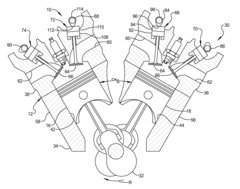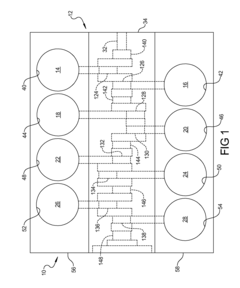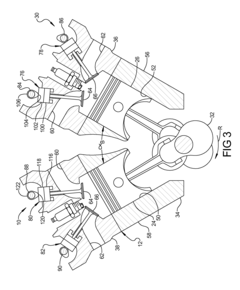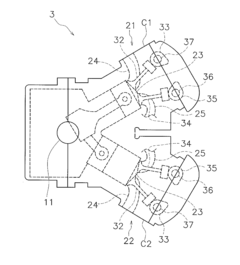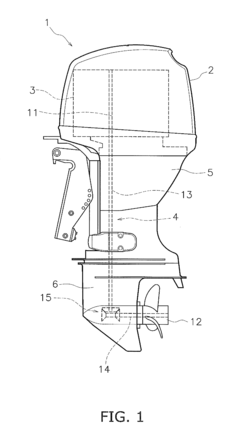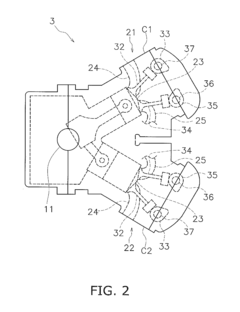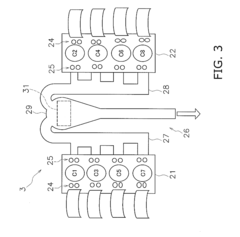V8 Engine Build: Essential Components and Their Functions
JUL 4, 20259 MIN READ
Generate Your Research Report Instantly with AI Agent
Patsnap Eureka helps you evaluate technical feasibility & market potential.
V8 Engine Overview and Objectives
The V8 engine, a marvel of automotive engineering, has been a cornerstone of high-performance vehicles for decades. This powerful and efficient engine configuration has evolved significantly since its inception, continually pushing the boundaries of power output, fuel efficiency, and reliability. The V8 engine's development trajectory has been shaped by advancements in materials science, combustion technology, and electronic control systems.
The primary objective of V8 engine technology is to deliver exceptional power and torque while maintaining optimal fuel efficiency and meeting increasingly stringent emissions standards. This balance between performance and environmental responsibility has driven continuous innovation in engine design and manufacturing processes. Modern V8 engines incorporate sophisticated technologies such as direct fuel injection, variable valve timing, and cylinder deactivation to achieve these goals.
Throughout its history, the V8 engine has adapted to changing market demands and regulatory requirements. From the early days of muscle cars to contemporary luxury vehicles and high-performance sports cars, the V8 has remained a symbol of automotive prowess. The ongoing development of V8 engines focuses on reducing weight, improving thermal efficiency, and integrating hybrid technologies to ensure their relevance in an era of electrification.
Key technological trends in V8 engine development include the use of lightweight materials such as aluminum and carbon fiber composites, advanced turbocharging and supercharging systems, and the implementation of smart engine management systems. These innovations aim to extract maximum performance from smaller displacement engines while reducing fuel consumption and emissions.
The future of V8 engine technology is likely to see further integration with electric powertrains, creating high-performance hybrid systems that combine the emotional appeal of a V8 with the efficiency benefits of electrification. This evolution will require advancements in areas such as energy recovery systems, compact electric motor integration, and sophisticated power management algorithms.
As we look ahead, the V8 engine faces challenges from alternative powertrain technologies and stricter environmental regulations. However, its enduring popularity and the continuous technological advancements suggest that the V8 will remain a significant player in the automotive landscape, particularly in high-performance and luxury vehicle segments. The ongoing research and development in V8 technology will be crucial in defining its role in the future of automotive propulsion.
The primary objective of V8 engine technology is to deliver exceptional power and torque while maintaining optimal fuel efficiency and meeting increasingly stringent emissions standards. This balance between performance and environmental responsibility has driven continuous innovation in engine design and manufacturing processes. Modern V8 engines incorporate sophisticated technologies such as direct fuel injection, variable valve timing, and cylinder deactivation to achieve these goals.
Throughout its history, the V8 engine has adapted to changing market demands and regulatory requirements. From the early days of muscle cars to contemporary luxury vehicles and high-performance sports cars, the V8 has remained a symbol of automotive prowess. The ongoing development of V8 engines focuses on reducing weight, improving thermal efficiency, and integrating hybrid technologies to ensure their relevance in an era of electrification.
Key technological trends in V8 engine development include the use of lightweight materials such as aluminum and carbon fiber composites, advanced turbocharging and supercharging systems, and the implementation of smart engine management systems. These innovations aim to extract maximum performance from smaller displacement engines while reducing fuel consumption and emissions.
The future of V8 engine technology is likely to see further integration with electric powertrains, creating high-performance hybrid systems that combine the emotional appeal of a V8 with the efficiency benefits of electrification. This evolution will require advancements in areas such as energy recovery systems, compact electric motor integration, and sophisticated power management algorithms.
As we look ahead, the V8 engine faces challenges from alternative powertrain technologies and stricter environmental regulations. However, its enduring popularity and the continuous technological advancements suggest that the V8 will remain a significant player in the automotive landscape, particularly in high-performance and luxury vehicle segments. The ongoing research and development in V8 technology will be crucial in defining its role in the future of automotive propulsion.
Market Demand for High-Performance JavaScript Engines
The demand for high-performance JavaScript engines has grown exponentially in recent years, driven by the increasing complexity of web applications and the expanding role of JavaScript in both client-side and server-side development. As web applications become more sophisticated, handling larger datasets and performing more complex computations, the need for efficient JavaScript execution has become paramount.
In the browser environment, users expect web applications to load quickly and respond instantaneously, regardless of the complexity of the underlying code. This has led to a surge in demand for JavaScript engines that can optimize code execution, reduce memory usage, and improve overall performance. Major tech companies and browser developers have invested heavily in improving their JavaScript engines to meet these demands, with Google's V8 engine being a prime example of this focus on performance.
The rise of Node.js has further amplified the market demand for high-performance JavaScript engines. As server-side JavaScript has gained popularity, businesses are increasingly relying on JavaScript for their backend systems. This shift has created a need for JavaScript engines that can handle high-concurrency scenarios and process large volumes of data efficiently, pushing the boundaries of what was previously thought possible with JavaScript.
The Internet of Things (IoT) and edge computing have also contributed to the growing demand for optimized JavaScript engines. With JavaScript being used in a wide range of devices, from smart home appliances to industrial sensors, there is a need for engines that can perform well on resource-constrained hardware while maintaining security and reliability.
In the realm of mobile development, the popularity of hybrid and progressive web applications has further increased the importance of JavaScript performance. Users expect native-like performance from these applications, putting pressure on JavaScript engines to deliver near-native speeds on mobile devices.
The financial sector has emerged as a significant driver of demand for high-performance JavaScript engines. With the rise of fintech and the digitization of financial services, real-time data processing and complex financial modeling are increasingly being performed using JavaScript. This has created a need for engines that can handle computationally intensive tasks with the utmost efficiency and accuracy.
As artificial intelligence and machine learning become more prevalent in web applications, there is a growing demand for JavaScript engines that can efficiently handle AI-related computations. This includes optimizations for tensor operations, neural network inference, and other AI-specific tasks that were once the domain of lower-level languages.
The gaming industry has also contributed to the market demand, with browser-based games becoming increasingly complex. High-performance JavaScript engines are crucial for delivering smooth gameplay experiences, handling physics simulations, and rendering graphics in real-time within the browser environment.
In the browser environment, users expect web applications to load quickly and respond instantaneously, regardless of the complexity of the underlying code. This has led to a surge in demand for JavaScript engines that can optimize code execution, reduce memory usage, and improve overall performance. Major tech companies and browser developers have invested heavily in improving their JavaScript engines to meet these demands, with Google's V8 engine being a prime example of this focus on performance.
The rise of Node.js has further amplified the market demand for high-performance JavaScript engines. As server-side JavaScript has gained popularity, businesses are increasingly relying on JavaScript for their backend systems. This shift has created a need for JavaScript engines that can handle high-concurrency scenarios and process large volumes of data efficiently, pushing the boundaries of what was previously thought possible with JavaScript.
The Internet of Things (IoT) and edge computing have also contributed to the growing demand for optimized JavaScript engines. With JavaScript being used in a wide range of devices, from smart home appliances to industrial sensors, there is a need for engines that can perform well on resource-constrained hardware while maintaining security and reliability.
In the realm of mobile development, the popularity of hybrid and progressive web applications has further increased the importance of JavaScript performance. Users expect native-like performance from these applications, putting pressure on JavaScript engines to deliver near-native speeds on mobile devices.
The financial sector has emerged as a significant driver of demand for high-performance JavaScript engines. With the rise of fintech and the digitization of financial services, real-time data processing and complex financial modeling are increasingly being performed using JavaScript. This has created a need for engines that can handle computationally intensive tasks with the utmost efficiency and accuracy.
As artificial intelligence and machine learning become more prevalent in web applications, there is a growing demand for JavaScript engines that can efficiently handle AI-related computations. This includes optimizations for tensor operations, neural network inference, and other AI-specific tasks that were once the domain of lower-level languages.
The gaming industry has also contributed to the market demand, with browser-based games becoming increasingly complex. High-performance JavaScript engines are crucial for delivering smooth gameplay experiences, handling physics simulations, and rendering graphics in real-time within the browser environment.
Current V8 Architecture and Challenges
V8, developed by Google, is an open-source JavaScript engine that powers Chrome and Node.js. Its current architecture is designed for high performance and efficiency, but it also faces several challenges in the rapidly evolving landscape of web technologies.
The core of V8's architecture is built around just-in-time (JIT) compilation, which translates JavaScript code into machine code at runtime. This approach allows V8 to optimize code execution based on real-time usage patterns. The engine employs a two-tier compilation system: the baseline compiler, which quickly produces unoptimized machine code, and the optimizing compiler, which generates highly optimized code for frequently executed functions.
One of the key components in V8's architecture is the garbage collector, responsible for automatic memory management. V8 uses a generational garbage collection strategy, dividing objects into young and old generations to optimize collection efficiency. However, as web applications become more complex and memory-intensive, maintaining low latency during garbage collection remains a significant challenge.
V8's parser and abstract syntax tree (AST) generator form another crucial part of its architecture. These components are responsible for transforming JavaScript source code into an intermediate representation that can be processed by the compiler. As JavaScript evolves with new language features, keeping the parser efficient and compatible with the latest ECMAScript specifications is an ongoing challenge.
The engine's type system, which infers and tracks types dynamically, is a critical feature for performance optimization. However, as JavaScript is a dynamically typed language, accurate type inference can be challenging, especially for complex codebases. This can sometimes lead to suboptimal code generation or unnecessary deoptimizations.
Another significant component of V8 is its implementation of WebAssembly, a low-level bytecode format designed for efficient execution. While WebAssembly offers near-native performance for web applications, integrating it seamlessly with JavaScript and optimizing its execution within V8 presents ongoing challenges.
V8 also includes a complex system of inline caches and hidden classes to optimize property access in JavaScript objects. While these mechanisms significantly improve performance for typical usage patterns, they can become less effective for highly dynamic code or unconventional object structures.
As web applications continue to grow in complexity and diversity, V8 faces the challenge of maintaining performance across a wide range of scenarios. This includes optimizing for both short-lived scripts and long-running applications, handling large amounts of data efficiently, and providing consistent performance across different devices and platforms.
The core of V8's architecture is built around just-in-time (JIT) compilation, which translates JavaScript code into machine code at runtime. This approach allows V8 to optimize code execution based on real-time usage patterns. The engine employs a two-tier compilation system: the baseline compiler, which quickly produces unoptimized machine code, and the optimizing compiler, which generates highly optimized code for frequently executed functions.
One of the key components in V8's architecture is the garbage collector, responsible for automatic memory management. V8 uses a generational garbage collection strategy, dividing objects into young and old generations to optimize collection efficiency. However, as web applications become more complex and memory-intensive, maintaining low latency during garbage collection remains a significant challenge.
V8's parser and abstract syntax tree (AST) generator form another crucial part of its architecture. These components are responsible for transforming JavaScript source code into an intermediate representation that can be processed by the compiler. As JavaScript evolves with new language features, keeping the parser efficient and compatible with the latest ECMAScript specifications is an ongoing challenge.
The engine's type system, which infers and tracks types dynamically, is a critical feature for performance optimization. However, as JavaScript is a dynamically typed language, accurate type inference can be challenging, especially for complex codebases. This can sometimes lead to suboptimal code generation or unnecessary deoptimizations.
Another significant component of V8 is its implementation of WebAssembly, a low-level bytecode format designed for efficient execution. While WebAssembly offers near-native performance for web applications, integrating it seamlessly with JavaScript and optimizing its execution within V8 presents ongoing challenges.
V8 also includes a complex system of inline caches and hidden classes to optimize property access in JavaScript objects. While these mechanisms significantly improve performance for typical usage patterns, they can become less effective for highly dynamic code or unconventional object structures.
As web applications continue to grow in complexity and diversity, V8 faces the challenge of maintaining performance across a wide range of scenarios. This includes optimizing for both short-lived scripts and long-running applications, handling large amounts of data efficiently, and providing consistent performance across different devices and platforms.
Core Components of V8 Engine
01 V8 Engine Design and Configuration
V8 engines are designed with eight cylinders arranged in two banks of four, forming a V-shape. This configuration allows for compact packaging, improved balance, and higher power output. Various designs exist, including cross-plane and flat-plane crankshafts, which affect the engine's characteristics and performance.- V8 Engine Design and Configuration: V8 engines are designed with eight cylinders arranged in two banks of four, forming a V-shape. This configuration allows for a compact design, improved balance, and higher power output compared to inline engines. Various aspects of V8 engine design, including cylinder arrangement, crankshaft configuration, and valve train systems, are continuously optimized for better performance and efficiency.
- Fuel Efficiency and Emissions Control: Modern V8 engines incorporate advanced technologies to improve fuel efficiency and reduce emissions. These may include direct fuel injection, variable valve timing, cylinder deactivation, and advanced exhaust gas recirculation systems. Innovations in engine management systems and combustion processes aim to meet stringent environmental regulations while maintaining high performance.
- Performance Enhancement and Tuning: Various methods and components are developed to enhance V8 engine performance. These include turbocharging, supercharging, intercooling, and high-flow intake and exhaust systems. Advanced materials and manufacturing techniques are employed to reduce weight, increase strength, and improve thermal efficiency of engine components.
- Cooling and Lubrication Systems: Effective cooling and lubrication are crucial for V8 engine reliability and longevity. Innovations in coolant flow design, oil pump efficiency, and thermal management systems help maintain optimal operating temperatures and reduce friction. Advanced cooling strategies may include precision coolant control and integrated thermal management systems.
- Integration with Hybrid and Electric Systems: As automotive technology evolves, V8 engines are being integrated with hybrid and electric systems to improve overall vehicle efficiency and performance. This includes the development of mild hybrid systems, regenerative braking technologies, and advanced power management strategies that combine the strengths of V8 engines with electric propulsion systems.
02 Fuel Efficiency and Emissions Improvements
Modern V8 engines incorporate technologies to enhance fuel efficiency and reduce emissions. These may include direct fuel injection, variable valve timing, cylinder deactivation, and advanced engine management systems. Such improvements help V8 engines meet stringent environmental regulations while maintaining performance.Expand Specific Solutions03 Performance Enhancements
Various methods are employed to boost V8 engine performance, including turbocharging, supercharging, and optimizing intake and exhaust systems. Advanced materials and manufacturing techniques are used to reduce weight and improve durability, allowing for higher revs and increased power output.Expand Specific Solutions04 Cooling and Lubrication Systems
Efficient cooling and lubrication are crucial for V8 engine reliability and performance. Innovations in these areas include improved coolant flow designs, oil pump efficiency, and the use of advanced lubricants. Some designs incorporate dry sump systems for high-performance applications.Expand Specific Solutions05 Integration with Hybrid and Electric Systems
To meet future efficiency demands, V8 engines are being integrated with hybrid and electric systems. This includes mild hybrid configurations, full hybrid powertrains, and even plug-in hybrid setups. These systems can provide additional power while improving overall fuel economy and reducing emissions.Expand Specific Solutions
Key Players in JavaScript Engine Development
The V8 engine build market is in a mature stage, with established players and well-defined technologies. The global market size for V8 engines is substantial, driven by demand in high-performance vehicles and luxury segments. Technologically, V8 engines have reached a high level of sophistication, with companies like GM Global Technology Operations, Ford Global Technologies, and Toyota Motor Corp. leading innovation. These firms, along with others such as BMW and Honda Motor Co., continue to refine V8 designs for improved efficiency and performance. However, the industry faces challenges from stricter emissions regulations and the shift towards electrification, prompting companies to explore hybrid V8 systems and alternative powertrains.
GM Global Technology Operations LLC
Technical Solution: GM's V8 engine build focuses on advanced technologies to enhance performance and efficiency. Their latest V8 engines incorporate direct fuel injection, variable valve timing, and cylinder deactivation[1]. The direct injection system precisely controls fuel delivery, improving combustion efficiency and power output. Variable valve timing optimizes engine breathing across the RPM range, enhancing both low-end torque and high-end power. Cylinder deactivation technology allows the engine to operate on four cylinders under light load conditions, significantly improving fuel economy[2]. GM also utilizes advanced materials such as aluminum for the engine block and heads to reduce weight while maintaining strength[3].
Strengths: Improved fuel efficiency, enhanced performance across RPM range, reduced emissions. Weaknesses: Complexity may increase maintenance costs, potential reliability issues with advanced systems.
Bayerische Motoren Werke AG
Technical Solution: BMW's V8 engine build emphasizes high performance and efficiency. Their latest V8 engines feature a "hot V" configuration, where the turbochargers are placed within the V of the engine for compact packaging and reduced lag[10]. The engine utilizes direct fuel injection with piezo injectors for precise fuel delivery and improved combustion efficiency. BMW employs Valvetronic, a fully variable valve control system that replaces the traditional throttle valve, allowing for more efficient engine breathing and improved fuel economy[11]. The engine block is made from aluminum-silicon alloy, with a closed-deck design for increased rigidity. BMW also incorporates a cross-bank exhaust manifold, which improves exhaust gas flow and enhances turbocharger response[12].
Strengths: High specific output, excellent throttle response, advanced technologies for efficiency. Weaknesses: Complexity may lead to higher maintenance costs, potential reliability concerns with advanced systems.
Innovative Features in V8 Engine Design
Engine assembly including crankshaft for v8 arrangement
PatentInactiveUS20120210958A1
Innovation
- A V8 engine crankshaft design with rotationally offset and aligned crank pins, allowing for primary balance without balance shafts and maintaining consistent firing intervals across all eight cylinders, as well as during operation with six or seven cylinders, through a specific arrangement of crank pins and bearing journals.
V8 engine and outboard motor
PatentActiveUS20160341097A1
Innovation
- A V8 engine design with a simple construction featuring aggregated exhaust pathways and adjustable exhaust cams, where the central angle of exhaust cams for each cylinder is optimized to minimize valve overlap and reduce exhaust interference, allowing for even firing intervals and improved exhaust gas management.
V8 Integration with Web Browsers
The integration of the V8 JavaScript engine with web browsers represents a crucial aspect of modern web development. This integration enables browsers to execute JavaScript code efficiently, providing a seamless and responsive user experience. The process involves several key components and mechanisms that work together to ensure smooth operation.
At the core of this integration is the embedding of V8 within the browser's architecture. This embedding allows the browser to leverage V8's high-performance capabilities for JavaScript execution. The browser's rendering engine, responsible for parsing and displaying HTML and CSS, communicates directly with V8 to handle JavaScript code encountered during page loading and interaction.
One of the primary interfaces between V8 and the browser is the Document Object Model (DOM). V8 provides JavaScript with access to the DOM, allowing scripts to manipulate the structure, content, and style of web pages dynamically. This interaction is facilitated through a set of APIs that bridge the gap between V8's JavaScript execution environment and the browser's internal representation of the web page.
The event loop plays a critical role in managing the asynchronous nature of web applications. V8 integrates with the browser's event loop to handle JavaScript callbacks, promises, and other asynchronous operations. This integration ensures that JavaScript execution does not block the browser's UI thread, maintaining responsiveness even during complex computations or network requests.
Memory management is another crucial aspect of V8's integration with web browsers. V8 employs its own garbage collection mechanisms, which must work in harmony with the browser's memory management systems. This coordination prevents memory leaks and ensures efficient use of system resources, particularly important for long-running web applications or those handling large amounts of data.
Security considerations are paramount in the integration process. V8 implements various security measures, such as the same-origin policy and content security policies, in collaboration with the browser's security model. These measures protect users from malicious scripts and ensure that JavaScript execution occurs within appropriate boundaries.
Performance optimization is a key focus of V8's integration. Techniques such as just-in-time (JIT) compilation and inline caching are employed to accelerate JavaScript execution. These optimizations are carefully tuned to work within the constraints of the browser environment, balancing speed with memory usage and startup time.
The integration also extends to developer tools, with V8 providing debugging and profiling capabilities that are exposed through the browser's development console. This allows developers to inspect, debug, and optimize their JavaScript code directly within the browser environment.
At the core of this integration is the embedding of V8 within the browser's architecture. This embedding allows the browser to leverage V8's high-performance capabilities for JavaScript execution. The browser's rendering engine, responsible for parsing and displaying HTML and CSS, communicates directly with V8 to handle JavaScript code encountered during page loading and interaction.
One of the primary interfaces between V8 and the browser is the Document Object Model (DOM). V8 provides JavaScript with access to the DOM, allowing scripts to manipulate the structure, content, and style of web pages dynamically. This interaction is facilitated through a set of APIs that bridge the gap between V8's JavaScript execution environment and the browser's internal representation of the web page.
The event loop plays a critical role in managing the asynchronous nature of web applications. V8 integrates with the browser's event loop to handle JavaScript callbacks, promises, and other asynchronous operations. This integration ensures that JavaScript execution does not block the browser's UI thread, maintaining responsiveness even during complex computations or network requests.
Memory management is another crucial aspect of V8's integration with web browsers. V8 employs its own garbage collection mechanisms, which must work in harmony with the browser's memory management systems. This coordination prevents memory leaks and ensures efficient use of system resources, particularly important for long-running web applications or those handling large amounts of data.
Security considerations are paramount in the integration process. V8 implements various security measures, such as the same-origin policy and content security policies, in collaboration with the browser's security model. These measures protect users from malicious scripts and ensure that JavaScript execution occurs within appropriate boundaries.
Performance optimization is a key focus of V8's integration. Techniques such as just-in-time (JIT) compilation and inline caching are employed to accelerate JavaScript execution. These optimizations are carefully tuned to work within the constraints of the browser environment, balancing speed with memory usage and startup time.
The integration also extends to developer tools, with V8 providing debugging and profiling capabilities that are exposed through the browser's development console. This allows developers to inspect, debug, and optimize their JavaScript code directly within the browser environment.
V8 Performance Benchmarking Methods
Performance benchmarking is crucial for evaluating and optimizing the V8 engine's efficiency. The primary methods for V8 performance benchmarking involve a combination of synthetic tests, real-world application scenarios, and specialized tools designed to measure various aspects of JavaScript execution.
One of the most widely used benchmarking suites for V8 is the Octane benchmark, developed by Google. Octane consists of 17 individual tests that cover a range of JavaScript use cases, from simple arithmetic operations to complex DOM manipulations. These tests are designed to simulate real-world scenarios and provide a comprehensive view of V8's performance across different types of JavaScript applications.
Another important benchmarking tool is the JetStream benchmark suite, which combines a variety of JavaScript and WebAssembly benchmarks. JetStream is particularly useful for assessing V8's performance in modern web applications, as it includes tests for both traditional JavaScript execution and the newer WebAssembly format.
For more specific performance measurements, the V8 team and developers often use microbenchmarks. These are small, focused tests that target particular aspects of the engine's performance, such as function call overhead, object creation, or garbage collection efficiency. Microbenchmarks are valuable for identifying performance bottlenecks and measuring the impact of specific optimizations.
Real-world application benchmarking is also essential for assessing V8's performance in practical scenarios. This involves running popular web applications and measuring metrics such as load time, execution speed, and memory usage. Tools like Chrome's DevTools and Lighthouse can be used to gather these performance metrics in real-world contexts.
Profiling tools play a significant role in V8 performance benchmarking. The V8 engine includes built-in profiling capabilities that allow developers to analyze the execution of JavaScript code in detail. These profilers can identify hot spots in the code, track memory allocation, and provide insights into the effectiveness of various optimizations.
Comparative benchmarking is another crucial aspect of V8 performance evaluation. This involves running the same tests on different versions of V8 or comparing V8's performance against other JavaScript engines like SpiderMonkey or JavaScriptCore. Such comparisons help track improvements over time and identify areas where V8 may be lagging behind competitors.
Lastly, stress testing and edge case analysis are important components of V8 benchmarking. These tests push the engine to its limits by running extremely large or complex scripts, handling massive amounts of data, or executing in resource-constrained environments. Such tests help ensure V8's stability and performance under extreme conditions.
One of the most widely used benchmarking suites for V8 is the Octane benchmark, developed by Google. Octane consists of 17 individual tests that cover a range of JavaScript use cases, from simple arithmetic operations to complex DOM manipulations. These tests are designed to simulate real-world scenarios and provide a comprehensive view of V8's performance across different types of JavaScript applications.
Another important benchmarking tool is the JetStream benchmark suite, which combines a variety of JavaScript and WebAssembly benchmarks. JetStream is particularly useful for assessing V8's performance in modern web applications, as it includes tests for both traditional JavaScript execution and the newer WebAssembly format.
For more specific performance measurements, the V8 team and developers often use microbenchmarks. These are small, focused tests that target particular aspects of the engine's performance, such as function call overhead, object creation, or garbage collection efficiency. Microbenchmarks are valuable for identifying performance bottlenecks and measuring the impact of specific optimizations.
Real-world application benchmarking is also essential for assessing V8's performance in practical scenarios. This involves running popular web applications and measuring metrics such as load time, execution speed, and memory usage. Tools like Chrome's DevTools and Lighthouse can be used to gather these performance metrics in real-world contexts.
Profiling tools play a significant role in V8 performance benchmarking. The V8 engine includes built-in profiling capabilities that allow developers to analyze the execution of JavaScript code in detail. These profilers can identify hot spots in the code, track memory allocation, and provide insights into the effectiveness of various optimizations.
Comparative benchmarking is another crucial aspect of V8 performance evaluation. This involves running the same tests on different versions of V8 or comparing V8's performance against other JavaScript engines like SpiderMonkey or JavaScriptCore. Such comparisons help track improvements over time and identify areas where V8 may be lagging behind competitors.
Lastly, stress testing and edge case analysis are important components of V8 benchmarking. These tests push the engine to its limits by running extremely large or complex scripts, handling massive amounts of data, or executing in resource-constrained environments. Such tests help ensure V8's stability and performance under extreme conditions.
Unlock deeper insights with Patsnap Eureka Quick Research — get a full tech report to explore trends and direct your research. Try now!
Generate Your Research Report Instantly with AI Agent
Supercharge your innovation with Patsnap Eureka AI Agent Platform!
